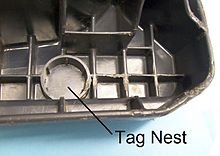User:GDpost/sandbox
Operational Requirement
[edit]
Modern cities have at least one waste bin per household, often more when waste is segregated for recycling. The same style of waste bin is also used by small businesses, such as restaurants. Refuse collection trucks (RCVs) have automated equipment to service these bins at rates up to 200 to 300 per hour. The crew of a RCV are relied on to service the correct bins for planned area and to avoid bins which may be unauthorized. Typical malpractice is for a householder or business to acquire additional bins and then to mislead (or coerce) the RCV crew to service them without paying any additional fees to the authorities. Each bin lifted needs to be identified to a paying client
Authorities need to comply with the European Landfill Directive 1999/31/EC. "[1]" Where cities have provided additional recycling bins, they need to monitor whether the bins are indeed being used at all.
Bins, valued at approx. €30 each, are an asset to the authorities, placed into the care (not ownership) of the public. Being highly mobile and placed out in the street, they do get stolen, damaged or moved to another address (or use) by mistake. Private waste collection contractors provide their own bins which sometimes get mixed up with other contractors or the municipal authorities. This is a typical asset-tracking requirement.
Placing an RFID tag on each bin, and an RFID reader on each truck, enables instantaneous logging of which bin is serviced where and when. This places no additional strain on the RCV crew and the data flows to a back office where location, frequency and payment balances are checked.
Systems do exist where the RCV's lifter mechanism will refuse to service an unauthorized bin, but this has to be balanced against the health risk of leaving the waste behind to fester or be dumped illegally. Typically the RCV crew will service all bins at high speed, relying on the back office to sort out non-payments, arrears, etc.
History
[edit]
At the end of the 80s, the competing plastic waste bin producers Fritz Schafer GmbH (Schafer) and Sulo Eisenwerk Streuber & Lohmann GmbH & CO. KG (SULO) developed automated identification of waste bins by means of RFID tags. Fixing the tag to the bin was a problem, until Schafer patented the tag nest (EP0495947A1) in 1990 (with no mention of RFID) and Deutsche Aerospace AG (DASA) patented (DE4238225) a method of retrofitting an RFID tag in 1992. Envicomp Entsorgungssysteme GmbH & CO. KG was founded by Sulo and they aquired the DASA patent in 1998. Schafer let their patent lapse at about the same time. Balluff GmbH was one of the first companies to produce the special 30mm diameter RFID puck waste bin tag.
Whereas Schafer and SULO immediately introduced their tag nest in all their new bin moulds, there was slow introduction with other bin producers. The bin moulds have quite a long lifespan and other bin producers had to negotiate licences if they wanted to use the new RFID technology on replacement moulds. European Standard EN14803 (Identifaction and/or determination of the quantity of waste) was agreed by CENELEC in 2005 and it mentions the licencing required from Envicomp (who by this time had been sold by SULO to Plastic Omnium).
The cylinder tag method of retrofitting tags to bins without tag nests was patented by TagPro (ZA2007/07059) in 2007. The patent is only requires licencing in South Africa.
The original DASA patent expired in November 2012. Under EN840 (Mobile waste containers) it is required that all bins must now be produced with the 30mm tag nest.


Use of RFID for Waste Management
[edit]The use of RFID on waste containers has been very much misunderstood, and mistrusted, by the general public. In brief, the RFID tag fulfills the same purpose, and has the same limitations as a number plate on a vehicle. It contains a unique number denoting a particular vehicle (or waste container in this case). It does not have the ability to sense the nature of the load in the vehicle or the bin. The promoters of RFID for waste containers are possibly guilty of over-selling RFID in this application, causing a negative backlash from the public who have been led to believe that these tags will be spying on them. The same public readily accepts that cars must have number plates. In the event of the Refuse Collecting Vehicle(RCV) being equipped with matching RFID readers, the only thing that will be read is: "bin number 01A4F6BC81(example) was emptied now". Anyone else with a matching handheld reader will also be limited to reading the number 01A4F6BC81. Modern RCVs already have trackers logging their GPS position against time and the bin's RFID number is added as a further column of data sent to a central computer for processing. The analysis of the data provides for the waste management aspects[1] which have mistakenly been attributed to RFID per se.
In America
[edit]Chesapeake, VA supplied recycling bins with RFID tags, so that it could identify residents who were not using the recycling bins. Within one year, recycling tonnage had increased from 4,807 tons in 2009 to 15,447 tons in 2010.[2]
The city of Cleveland, OH with 152 000 households is providing 2 carts per household (waste & recyclables), each cart with an RFID tag.
Charleston County, S.C has set up a pilot program with RFID tags in the waste bins of 5000 households.
Anne Arundel County, MD has made available optional 65gal carts with RFID tags for monitoring recycling[3]





- ^ http://www.iaeng.org/publication/WCE2010/WCE2010_pp29-33.pdf RFID and Integrated Technologies for Solid Waste Bin Monitoring System
- ^ http://waste360.com/radio-frequency-identification-rfid/cutting-back-keeping-track
- ^ http://www.aacounty.org/DPW/WasteManagement/RFIDInformation.cfm#.U4xZQGeKCUk

